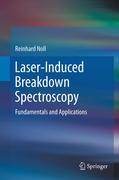
Laser-induced breakdown spectroscopy: fundamentals and applications
Noll, Reinhard
This book is a comprehensive source of the fundamentals, process parameters, instrumental components and applications of laser-induced breakdown spectroscopy (LIBS). The effect of multiple pulses on material ablation, plasma dynamicsand plasma emission is presented. A heuristic plasma modeling allows to simulate complex experimental plasma spectra. These methods and findings form the basis for a variety of applications to perform quantitative multi-element analysis with LIBS. These application potentials of LIBS have really boosted in thelast years ranging from bulk analysis of metallic alloys and non-conducting materials, via spatially resolved analysis and depth profiling covering measuring objects in all physical states: gaseous, liquid and solid. Dedicated chapters present LIBS investigations for these tasks with special emphasis on the methodical and instrumental concepts as well as the optimization strategies for a quantitative analysis. Requirements, concepts, design and characteristic features of LIBS instruments are described covering laboratory systems, inspections systems for in-line process control, mobile systems and remote systems. State-of-the-art industrial applications of LIBS systems are presented demonstrating the benefits of inline process control for improved process guiding and quality assurance purposes. Comprehensively presents fundamentals, principles and applications of LIBS. Explains the underlying physics and methodical approaches to optimize quantitative element analysis. Reviews a broad variety of applications fields for conducting and non-conducting materials; gaseous, liquid and solid materials, nanoparticles, including industrial applications. Indicates achieving world records in limit of detection and measuring frequency. INDICE: Introduction. Laser-induced breakdown spectroscopy. Process parameters. Instrumental components. Evaporation and plasma generation. Multiple-pulses for LIBS. Material ablation. Plasma dynamics and plasma parameters. Plasmaemission. Modeling of plasma emission. Quantitative analysis. Combination of LIBS and LIF. Bulk analysis of metallic alloys. Bulk analysis of non-conducting materials. Spatially resolved analysis. Depth profiling. LIBS instruments. Industrial applications.
- ISBN: 978-3-642-20667-2
- Editorial: Springer Berlin Heidelberg
- Encuadernacion: Cartoné
- Páginas: 400
- Fecha Publicación: 01/09/2011
- Nº Volúmenes: 1
- Idioma: Inglés
